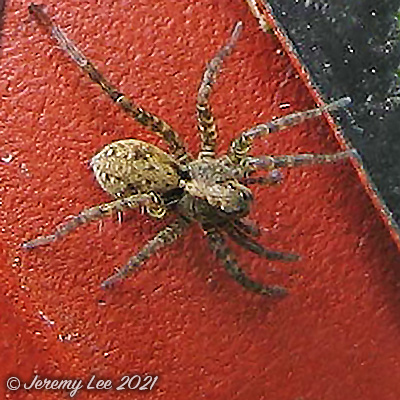
 |
|
Scientific Classifications explained » Amphibians » Ants » Aphids » Bees » Beetles » Birds » Bugs » Butterflies » Caterpillars » Damselflies » Dragonflies » Earwigs » Flies » Frog/Leafhoppers » Fungi » Galls » Grasshoppers » Harvestmen » Hoverflies » Lacewings » Ladybirds » Leaf Mines » Lichens » Mammals » Millipedes » Mosses » Moths » Sawflies » Slugs » Snails » Spiders » Trees » Wasps » Wild Flowers » Woodlice |
UK Nature > Spiders > Pardosa amentata

Scientific Name: Pardosa amentata Common Name: Wolf Spider Males of Pardosa amentata measure up to 5-6mm and the females up to 8mm in length. Dark grey or brown, sometimes almost black, usually with a pale stripe down the middle of the thorax and a pale band, often broken into dots, at each side. A fast running, diurnal hunter, usually scurrying over the ground or low vegetation in search of flies and other small insects. The female carries her eggs in a lens-shaped silken parcel attached to her spinnerets, and can often be seen sun-bathing at this time. When the spiderlings hatch, they climb onto the female's back and are carried around for a while, gradually dropping off to make their own way in the world. Male spiders can be sometimes seen signalling to the females by waving their black, clubbed palps. Adult in summer and autumn. Most open habitats with plenty of bare ground and some shelter and moisture; often found on garden rockeries. Common and widespread throughout the UK. |
|

https://www.uknature.co.uk is a website dedicated to showing the immense diversity of UK nature and wildlife. Our vast range of habitats, from lowland arable to snow covered mountains, from storm-ravaged coastlines to peaceful inland freshwater lakes and rivers, from dry, sandy heaths to deciduous and coniferous forests, all these habitats contribute to the abundance of UK nature. We have wild birds in huge numbers either residing or visiting our shores (597 recorded species as at July 2013) and we must also not forget the humble back garden with its grass lawns, flower beds filled with nectar rich flowers, shrubs and trees, all designed to attract huge numbers of insects such as bees, moths, butterflies and hoverflies; and finally the small ponds which provide safe havens for frogs, toads, newts and even slow worms and grass snakes. www.uknature.co.uk is the showcase for my personal passion, photographing uknature in all its glory. I sincerely hope you all enjoy the fruits of my labours. This site and all images contained therein is © Jeremy Lee 2004 - 2021. All Rights Reserved. Site design by Jeremy Lee. Site development & IT Support by Stuart Lee. |